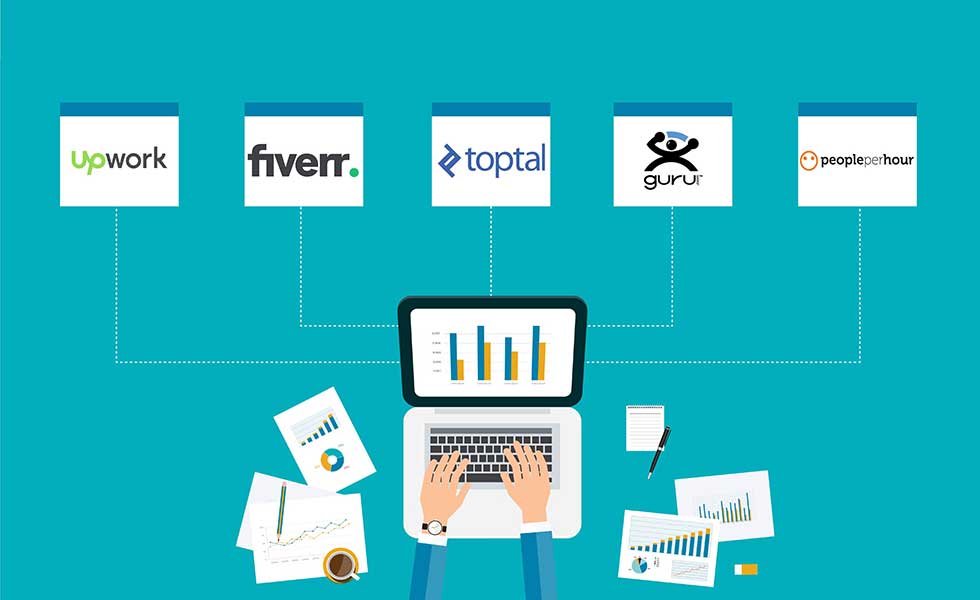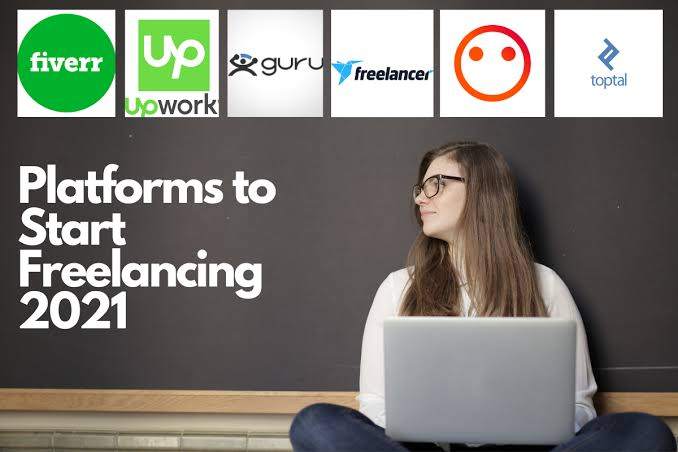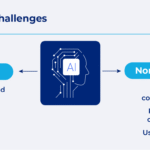Freelancing in 2025 looks different—in a good way. Remote-first companies, AI-powered workflows, and the rise of flexible teams mean there are more opportunities than ever to work online in the USA. But with so many marketplaces competing for your attention, which ones are truly the best freelance platforms 2025 has to offer?
This guide cuts through the noise. You’ll get plain-English reviews of the top freelancing sites in USA, a side-by-side comparison table, and practical tips to help you land better clients, faster. We’ll cover fees, protections, and who each platform is best for, so you can choose the right place to build your business and work online USA—with confidence.
How we picked the top Freelance Platforms

To make this list, a platform had to:
-
Serve a large US client base (or be US-headquartered)
-
Offer real buyer demand across popular categories
-
Provide clear payment processes and some form of dispute or payment protection
-
Be relevant to freelancers in 2025 (pricing, features, or policy updates this year)
The five that stand out right now on Freelance Platforms:
-
Upwork
-
Fiverr
-
Freelancer.com
-
Toptal
-
Contra
A deep dive into each—pros, cons, who it’s for, and what the money math actually looks like.
1. Upwork freelance platform — Best all-round marketplace for professionals
What it’s great for
If you want long-term client relationships, varied project types (hourly and fixed-price), and serious buyer demand, Upwork remains a powerhouse. It works across nearly every category: development, design, data, marketing, writing, admin, customer support, and more.
Pricing & fees (what to expect in 2025)
-
Freelancer service fee: variable 0–15% on new contracts (since May 1, 2025), and it stays fixed for the life of that contract. You’ll see your exact rate before you accept work. Upwork Support+1Upwork
-
Applying to jobs: “Connects” are required; Basic accounts include 10 free Connects/month, and you can buy more (commonly $0.15 each). UpworkUpwork Support
Payment protection & workflow
-
Fixed-price: client funds are held in escrow; you’re paid after submission and approval.
-
Hourly: Upwork’s Work Diary provides hourly protection when you follow the rules. Upwork Support
Pros
-
Huge client base and skill coverage
-
Contract-based messaging, milestones, and built-in escrow/hourly protection
-
You can lock in a good service-fee rate on a contract once it starts
Cons
-
You “pay to pitch” via Connects
-
The variable 0–15% fee can be higher for some contracts than the old flat 10% (depends on marketplace factors) Upwork Support
Best for
Mid-level to advanced freelancers who want steady work, recurring clients, and full-stack tools for proposals, milestones, and time tracking.
2. Fiverr — Best for productized services and quick turnarounds
What it’s great for
Selling clearly defined “packages” (Gigs) in design, video, voice, web tweaks, SEO micro-tasks, and other productized services. Clients self-serve by browsing your storefront—great if you prefer inbound orders over custom proposals.
Pricing & fees (2025 reality)
-
Freelancer (seller) cut: You keep 80% of the order value (Fiverr keeps 20%). Fiverr Help Center
-
Buyer fees: standard 5.5% service fee; small-order fee of $3.50 for purchases under $100 (per transaction). Fiverr.comFiverr Help Center
Tip: Fiverr’s own comparison content also reiterates a 20% seller commission and explains accelerated clearance for certain seller tiers (e.g., Top Rated/Pro). Fiverr.com
Payment protection & workflow
Delivery happens inside the order page; funds clear after a set period (typically 14 days; 7 days for higher-tier sellers). Disputes and revisions happen within the order thread. Fiverr.com
Pros
-
Super low friction for inbound leads (buyers browse and buy)
-
Perfect for repeatable packages and portfolio building
-
Strong traffic in creative and marketing categories
Cons
-
The 20% seller fee is steep compared to some rivals
-
Competitive categories can require heavy optimization to rank
Best for
Beginners and specialists who can package clear, fast-delivery offers (thumbnails, logo bundles, shorts edits, on-page SEO, etc.) and prefer a storefront model.
3. Freelancer.com — Best for massive variety (plus contests)
What it’s great for
Volume and variety. You’ll find everything from one-off data entry to complex dev builds, plus a robust Contests section for design and naming work.
Pricing & fees
-
Freelancer fees:
-
Fixed-price projects: 10% or $5 (whichever is greater)
-
Hourly projects: 10% on each payment
-
Contests: 10% or $5 (whichever is greater) when you win
These are set out on Freelancer.com’s official fees page. Freelancer+2Freelancer+2
-
-
Payment structure: Clients fund work using Milestone Payments—you’re paid when milestones are released. Freelancer
Pros
-
Enormous project variety, including contests
-
Familiar bid-and-milestone model
-
Useful for filling gaps between bigger contracts
Cons
-
10% fees add up on lower-value projects
-
Competition can be intense in commodity categories
Best for
Freelancers who don’t mind bidding volume, enjoy contests, and want access to a global job stream alongside US demand.
4. Toptal — Best for senior, vetted talent and premium clients
What it’s great for
Toptal is a curated network—think senior developers, designers, finance experts, PMs, and consultants. It’s ideal if you’ve got a strong track record and want fewer, higher-quality engagements.
Pricing & how the model works in 2025
-
For clients: Toptal operates with a $79/month platform subscription when you proceed with a talent search, and offers a no-risk trial (up to two weeks) on engagements. Toptal
-
For talent: Toptal vets applicants and positions itself as “top 3%.” The rigorous screening process is laid out on their site. Toptal
Pros
-
High-caliber, well-matched clients
-
Streamlined engagements with trial periods
-
Fewer proposals; more curated intros
Cons
-
Getting accepted is difficult (only a small percentage pass screening) Toptal
-
Not ideal if you’re just starting or need fast entry
Best for
Experienced US-market freelancers who want premium rates, fewer proposals, and curated matches (dev, design, data, finance, product/PM).
5. Contra — Best commission-free option for freelancers
What it’s great for
Contra positions itself as a commission-free network for independent work—great if you want to keep 100% of your earnings and invoice clients through a modern, portfolio-centric platform. Contra
Pricing & fees (who pays what)
-
Freelancers: 0% platform commission on earnings through Contra. Contra
-
Clients: Flat $29 fee per contract (one-time), or $29/month per contractor for ongoing projects; invoice fees began rolling out in 2025. Contra Help CenterContra Help Center
-
Payments: Global/US options (ACH, cards) via integrated processors. Contra
Pros
-
Keep 100% of your rate (no platform cut)
-
Clean portfolios and direct collaboration tools
-
Good fit for repeat client relationships
Cons
-
Client-side fees may be a hurdle for some buyers
-
Smaller overall marketplace than the giants (less passive job volume)
Best for
Portfolio-driven independents who bring or attract their own clients and want a sleek, commission-free workflow.
Comparison of Freelance Platforms (2025)
| Platform | Best for | Freelancer fee | Client/buyer fee | Payment protection | Vetting | Typical categories |
|---|---|---|---|---|---|---|
| Upwork | All-round professional marketplace; hourly + fixed-price | 0–15% (contract-dependent) Upwork Support | Client marketplace fees vary by program | Hourly protection & fixed-price escrow Upwork Support | Open marketplace | Dev, design, data, marketing, writing, admin |
| Fiverr | Productized services, fast turnarounds | 20% kept by Fiverr; seller gets 80% Fiverr Help Center | 5.5% + $3.50 under $100 Fiverr.comFiverr Help Center | Order-based, funds clear after set period Fiverr.com | Open marketplace | Creative, video, voice, web fixes, SEO |
| Freelancer.com | Huge variety + Contests | 10% (or $5 min) fixed; 10% hourly; 10% contests Freelancer | Client fees apply per their policy | Milestone Payments held/released by client Freelancer | Open marketplace | Dev, design, data, content, admin |
| Toptal | Senior experts + premium clients | Not a per-job commission model for talent (curated network) | $79/mo subscription for clients; trial engagements Toptal | Toptal-managed contracts with trial period Toptal | Vetted (≈ top 3%) Toptal | Dev, design, finance, PM, product |
| Contra | Commission-free portfolios + client relationships | 0% commission for freelancers Contra | $29 per contract or $29/mo ongoing per contractor; invoice fee rollout 2025 Contra Help CenterContra Help Center | Processor-backed payments; dispute assistance for contracts Contra Help Center | Open (portfolio-centric) | Design, dev, marketing, content |
NOTE: Fees and policies can change—always check each site’s current help or legal pages before you price a proposal.
Which Freelance Platforms should you choose?
If you want the broadest US demand
Pick Upwork. It’s the most balanced for professional services, with both short gigs and multi-month retainers, plus escrow and hourly protection. Upwork Support
If you sell repeatable packages
Choose Fiverr. A storefront makes inbound sales easier; just price with the 20% seller fee in mind and nudge buyers to bundle larger orders to reduce their small-order fees. Fiverr Help Center+1
If you like contests or quick bids
Try Freelancer.com. Contests are great for designers who want fast feedback; milestones are straightforward once you win. Freelancer+1
If you’re senior and want premium clients
Aim for Toptal. The vetting is tough, but matches can be excellent; clients operate with a subscription and a no-risk trial to start. Toptal+1
If you want to keep 100% of your rate
Go with Contra. It’s commission-free for freelancers; educate clients about the flat contract fee and highlight the total cost transparency. ContraContra Help Center
Practical tips to win more US clients in 2025
1. Clarify your offer in 8 seconds on
Your profile headline and first 2–3 lines should spell out: who you help, the outcome, and proof. Example: “Shopify CRO specialist—A/B tests that lift revenue 15–30%.”
2. Price with fees in mind (do the math once)
-
On Upwork, factor the 0–15% service fee and the cost of Connects into your target hourly or fixed rate. Upwork SupportUpwork
-
On Fiverr, add 25% buffer if you include revisions and anticipate order splits (seller 20% cut + buyer’s fee friction that may affect perceived price). Fiverr Help CenterFiverr.com
-
On Freelancer.com, build 10% into your milestone totals (and don’t forget the $5 minimum on small fixed bids). Freelancer
-
On Contra, pitch your full rate and flag that you’re commission-free (clients cover a flat fee). Contra Help Center
3. Lead with outcomes, show receipts
Replace task lists with business results: revenue lifted, CPA reduced, speed improved, bugs fixed, uptime increased. Add 2–3 short case snippets to your profile and proposals.
4. Use quick-close assets
-
Fiverr/Upwork Project Catalog: pre-scoped offers with crystal-clear deliverables and timelines
-
Short Loom video: 60–90 seconds to audit a prospect’s site/ad/app (works for Upwork and Contra)
-
Template library: proposals, onboarding checklists, status updates—brings consistency and speed
5. Protect yourself (and your client)
-
Stay on-platform until you have a contract; it preserves payment protection and dispute options. Upwork Support
-
Scope in writing: include limits, rounds of revisions, change-order fees, and delivery formats
-
Milestones matter: split big work into smaller funded steps (Freelancer Milestones; Upwork fixed-price). Freelancer
-
Taxes & forms: US clients may request W-9 information; non-US freelancers often use W-8BEN. (This is not tax advice—check with a qualified professional.)
6. Optimize for US time zones
Offer 1–2 overlapping hours with a client’s workday (Eastern or Pacific) for stand-ups and reviews. Quick replies win projects.
7. Lean into AI without overselling it
Use AI for drafts, patterns, QA, and data cleansing—but keep your human edge for strategy, creativity, and client communication.
FAQs:
Which freelance platforms is best for beginners?
Fiverr is beginner-friendly thanks to its storefront model (buyers browse and buy), and Upwork is great once you can write solid proposals and showcase proof. If your work packages nicely (logos, reels, landing page audits), start on Fiverr; if you prefer custom projects and ongoing retainers, try Upwork. Fiverr Help CenterFiverr.comUpwork Support
Which Freelance Platforms pays the most?
Pay depends more on skill, positioning, and proof than the site. That said, curated networks like Toptal often support higher bill rates for senior specialists, while Upwork has deep demand for mid- to senior-level roles. Toptal
Which Freelance Platforms has the lowest fees for freelancers?
Contra charges 0% commission to freelancers (clients pay a flat fee). Among the large marketplaces, Upwork’s fee varies 0–15% by contract; Fiverr keeps 20% of the order; Freelancer.com takes 10%. ContraUpwork SupportFiverr Help CenterFreelancer
Do these Freelance Platforms offer payment protection?
Yes—Upwork has hourly protection and fixed-price escrow; Freelancer.com uses Milestone Payments; Fiverr holds funds until delivery is approved. Contra supports compliant payments and provides dispute assistance for contracts. Always read each platform’s current policies. Upwork SupportFreelancerFiverr.comContra Help Center
What’s the fastest way to land a first US client?
Package a small, high-value starter offer (e.g., “Fix your GA4 conversion events in 48 hours”) with clear outcomes and a short timeline. Add a 60-second audit video to your proposal or gig. Follow up once—professionally.
Final thoughts:
The best freelance platforms 2025 (and how to win)
The top freelancing sites in USA each have a lane:
-
Upwork for balanced, professional work with built-in protections
-
Fiverr for productized offers and inbound orders
-
Freelancer.com for massive variety and contest-driven wins
-
Toptal for curated, senior-level engagements
-
Contra for commission-free earnings and direct client relationships
There’s no one “best” platform for everyone—but there is a best sequence: start where your offer fits (Fiverr for packages, Upwork for proposals), then branch out. As you grow, curate the work online USA clients you enjoy, raise your rate to reflect your outcomes, and move toward longer-term relationships on whichever platform supports your goals.
If you apply the tips here—outcome-driven profiles, price with fees in mind, protect scope with milestones, respond fast in US hours—you’ll turn platforms into pipelines. And that’s how you build a freelance business that lasts.



This is a super helpful guide! The clear breakdown of platform pros, cons, and fees makes it much easier to choose the right fit for my freelance work. Thanks for the practical advice!
Somebody essentially help to make significantly articles Id state This is the first time I frequented your web page and up to now I surprised with the research you made to make this actual post incredible Fantastic job